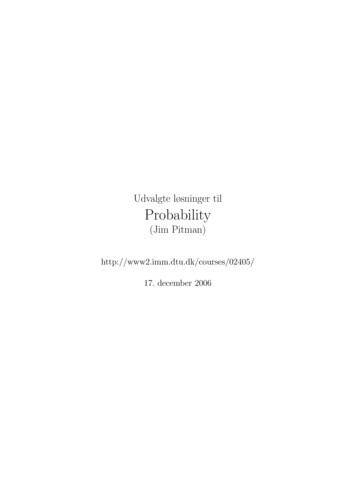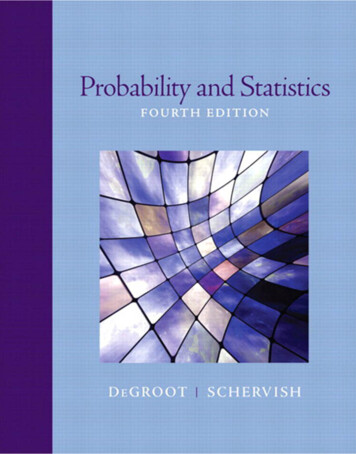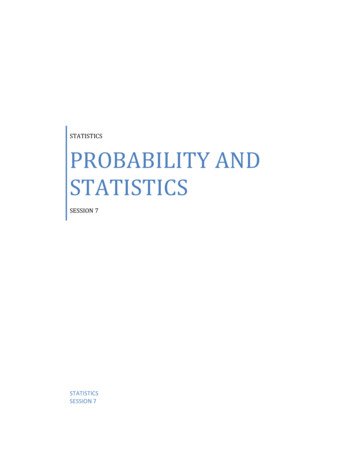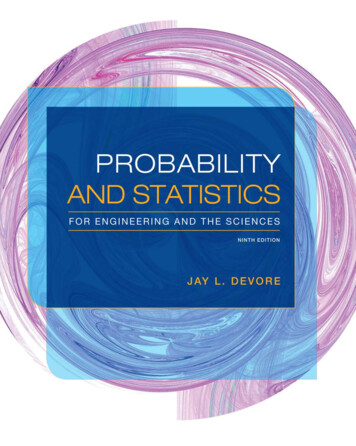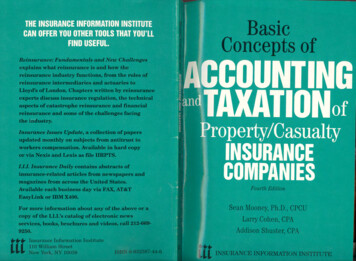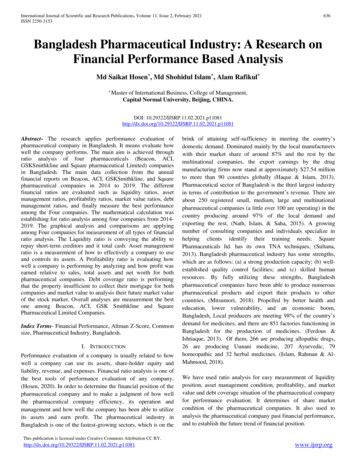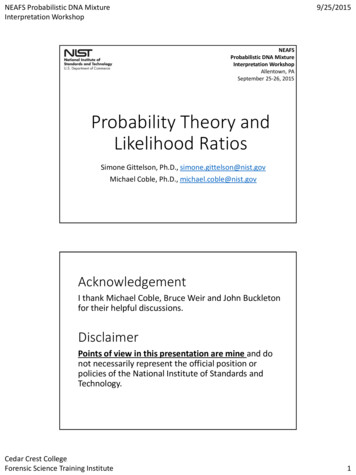
Transcription
NEAFS Probabilistic DNA MixtureInterpretation Workshop9/25/2015NEAFSProbabilistic DNA MixtureInterpretation WorkshopAllentown, PASeptember 25-26, 2015Probability Theory andLikelihood RatiosSimone Gittelson, Ph.D., simone.gittelson@nist.govMichael Coble, Ph.D., michael.coble@nist.govAcknowledgementI thank Michael Coble, Bruce Weir and John Buckletonfor their helpful discussions.DisclaimerPoints of view in this presentation are mine and donot necessarily represent the official position orpolicies of the National Institute of Standards andTechnology.Cedar Crest CollegeForensic Science Training Institute1
NEAFS Probabilistic DNA MixtureInterpretation Workshop9/25/2015Probability TheoryVocabulary and Notationrolling a 6 and a 1it will snow tomorrowobserving a peak for allele 88Mr. X stabbed Mr. YCedar Crest CollegeForensic Science Training Institute2
NEAFS Probabilistic DNA MixtureInterpretation Workshop9/25/2015Vocabulary and y and NotationBut I do not knowwhich one is true?!?I am uncertain.COMPLEMENT event or proposition𝑅 𝑅𝑆 𝑆𝐸 𝐸8𝐻 𝐻Cedar Crest CollegeForensic Science Training Institute3
NEAFS Probabilistic DNA MixtureInterpretation Workshop9/25/2015Vocabulary and �)Laws of ProbabilityLaw #1: A probability can take any value between 0 and 1,including 0 and 1.certain1 certainty that statement is true0.750.660.5EXAMPLE: rolling a 6-sided die𝑃𝑟 1,2,3,4,5 𝑜𝑟 6 1𝑃𝑟 7 00.330.250certainty that statement is falseimpossibleCedar Crest CollegeForensic Science Training Institute4
NEAFS Probabilistic DNA MixtureInterpretation Workshop9/25/2015Laws of ProbabilityLaw #2: The probability of event A or event B occurring isequal to the probability of event A plus the probability ofevent B minus the probability of event A and B.Pr 𝐴 𝑜𝑟 𝐵 Pr 𝐴 Pr 𝐵 Pr(𝐴 𝑎𝑛𝑑 𝐵)𝑃𝑟 𝐴 𝑜𝑟 𝐵 𝑃𝑟 𝐴 𝑃𝑟 𝐵event Aevent B𝑃𝑟 𝐴 𝑜𝑟 𝐴 𝑃𝑟 𝐴 𝑃𝑟 𝐴 1A: rolling an odd number B: rolling a 2Second Law of ProbabilityBlood groups:OABAB0.450.400.110.041. What is the probability that a person drawnrandomly from this population is blood group type Aor AB?2. What is the probability that a person drawnrandomly from this population is not blood grouptype AB?data from: od-typesCedar Crest CollegeForensic Science Training Institute5
NEAFS Probabilistic DNA MixtureInterpretation Workshop9/25/20151. What is the probability that a person drawn randomlyfrom this population is blood group type A or AB?Blood 100%0.550%0.510%0.360.0160%0.44A.B.C.D.E.O2. What is the probability that a person drawn randomlyfrom this population is not blood group type AB?Blood ar Crest CollegeForensic Science Training .D.E.O6
NEAFS Probabilistic DNA MixtureInterpretation Workshop9/25/2015Laws of ProbabilityLaw #2: The probability of event A or event B occurring isequal to the probability of event A plus the probability ofevent B minus the probability of event A and B.Pr 𝐴 𝑜𝑟 𝐵 Pr 𝐴 Pr 𝐵 Pr(𝐴 𝑎𝑛𝑑 𝐵)event Aevent BA: rolling an odd number𝑃𝑟 𝐴 𝑜𝑟 𝐵 𝑃𝑟 𝐴 𝑃𝑟 𝐵 𝑃𝑟 𝐴 𝑎𝑛𝑑 𝐵B: rolling a number greaterthan 2Second Law of ProbabilityBlood groups:OABAB0.450.400.110.043. What is the probability that a person drawnrandomly from this population has a blood groupthat contains an A (groups A and AB) or a bloodgroup that contains a B (groups B and AB)?data from: od-typesCedar Crest CollegeForensic Science Training Institute7
NEAFS Probabilistic DNA MixtureInterpretation Workshop9/25/20153. What is the probability that a person drawn randomly from thispopulation has a blood group that contains an A (groups A andAB) or a blood group that contains a B (groups B and AB)?Blood Laws of ProbabilityLaw #3: The probability of event A and event B occurring isequal to the probability of event A times the probability ofevent B.Pr 𝐴 𝑎𝑛𝑑 𝐵 Pr 𝐴 Pr 𝐵 𝐴 Pr(𝐵) Pr(𝐴 𝐵)event Aevent BA: rolling an odd numberCedar Crest CollegeForensic Science Training InstituteB: rolling a 3 or less8
NEAFS Probabilistic DNA MixtureInterpretation Workshop9/25/2015How Tall is Stefanie?Conditional Probabilities100BA1040What is 𝑃𝑟 𝐵 ?What is 𝑃𝑟 𝐵 𝐴 ?Cedar Crest CollegeForensic Science Training Institute1010010409
NEAFS Probabilistic DNA MixtureInterpretation Workshop9/25/2015Third Law of Probability(independent events)Blood groups:OABAB0.450.400.110.04Rh factor: -0.820.184. What is the probability that a person drawn randomlyfrom this population is blood group type A and Rh ?data from: od-types4. What is the probability that a person drawn randomlyfrom this population is blood group type A and Rh ?Rh factor:Blood groups:OABAB -0.450.400.110.040.820.180%0%Cedar Crest CollegeForensic Science Training .821.220.072A.B.C.D.E.10
NEAFS Probabilistic DNA MixtureInterpretation Workshop9/25/2015Third Law of Probabilityhair azelgreen0.390.360.150.10eye color:5. What is the probability that a person drawn randomlyfrom this population has blond hair and blue eyes?data from: /Third Law of Probability(dependent events)hair color:blackbrownredblond0.160.460.120.26eye color of blond haired people:brownbluehazelgreen0.050.790.060.105. What is the probability that a person drawn randomlyfrom this population has blond hair and blue eyes?data from: /Cedar Crest CollegeForensic Science Training Institute11
NEAFS Probabilistic DNA MixtureInterpretation Workshop9/25/20155. What is the probability that a person drawn randomlyfrom this population has blond hair and blue eyes?eye color of blond haired people:hair .Hardy-Weinberg LawHomozygote𝑃𝑟 28,28 𝑃𝑟 𝑝𝑎𝑡𝑒𝑟𝑛𝑎𝑙 𝑎𝑙𝑙𝑒𝑙𝑒 28 𝑃𝑟 𝑚𝑎𝑡𝑒𝑟𝑛𝑎𝑙 𝑎𝑙𝑙𝑒𝑙𝑒 28fathermother2828 𝑝28 𝑝282 𝑝28𝑝28 0.159{28,28}Cedar Crest CollegeForensic Science Training Institute𝑃𝑟 28,28 0.159 0.025212
NEAFS Probabilistic DNA MixtureInterpretation Workshop9/25/2015Hardy-Weinberg LawHeterozygote𝑃𝑟 13,16 𝑃𝑟 𝑝𝑎𝑡𝑒𝑟𝑛𝑎𝑙 𝑎𝑙𝑙𝑒𝑙𝑒 13 𝑃𝑟 𝑚𝑎𝑡𝑒𝑟𝑛𝑎𝑙 𝑎𝑙𝑙𝑒𝑙𝑒 16 𝑃𝑟 𝑝𝑎𝑡𝑒𝑟𝑛𝑎𝑙 𝑎𝑙𝑙𝑒𝑙𝑒 16 𝑃𝑟 𝑚𝑎𝑡𝑒𝑟𝑛𝑎𝑙 𝑎𝑙𝑙𝑒𝑙𝑒 13father 𝑝13 𝑝16 𝑝16 𝑝13mother13 or 16 𝑝13 𝑝16 𝑝16 𝑝1316 or 13 2𝑝13 𝑝16{13,16}Hardy-Weinberg LawHeterozygotefathermother13 or 16𝑝13 0.33016 or 13 𝑝16 0.033{13,16}Cedar Crest CollegeForensic Science Training Institute𝑃𝑟 13,16 2 0.330 0.033 0.02213
NEAFS Probabilistic DNA MixtureInterpretation Workshop9/25/2015Laws of ProbabilityLaw of total probability or the extension of the conversation:The probability of event A can be partitioned into the sumof probabilities of event A conditioned on mutually exclusiveand exhaustive events.event Aevent BPr(𝐴) Pr 𝐴 𝐵 Pr 𝐵 Pr(𝐴 𝐵) Pr(𝐵)Law of Total Probabilityhair color:blackbrownredblond0.160.460.120.26eye color:brownbluehazelgreenblack hair0.690.170.100.04brown hair0.460.240.200.10red hair0.430.190.190.19blond hair0.050.790.060.106. What is the probability that a person drawn randomlyfrom this population has blue eyes?Cedar Crest CollegeForensic Science Training Institute14
NEAFS Probabilistic DNA MixtureInterpretation Workshop9/25/20156. What is the probability that a person drawnrandomly from this population has blue .170.0000140%0.365A.B.C.D.E.Conditional Probability𝐻: the animal is an elephant𝐸: the animal has four legs?1 leg2 legs3 legsgiven:4 legsPr(𝐸 𝐻) 1Cedar Crest CollegeForensic Science Training Institute ?given:4 legsPr(𝐻 𝐸)15,00015
NEAFS Probabilistic DNA MixtureInterpretation Workshop9/25/2015𝐻: This man is Santa Claus.𝐸: This man has a white beard.Pr(𝐸 𝐻) ?A. The probability that thisman is Santa Claus giventhat he has a white beard.B. The probability that thisman has a white beardgiven that he is SantaClaus.C. both A) and B) are correctD. none of the aboveE. I am completely lost0%0%0%A.B.C.0%0%0%A.B.0%0%D.E.𝐻: This man is Santa Claus.𝐸: This man has a white beard.Pr(𝐻 𝐸) ?A. The probability that thisman is Santa Claus giventhat he has a white beard.B. The probability that thisman has a white beardgiven that he is SantaClaus.C. both A) and B) are correctD. none of the aboveE. I am completely lostCedar Crest CollegeForensic Science Training InstituteC.0%0%D.E.16
NEAFS Probabilistic DNA MixtureInterpretation Workshop9/25/2015𝐻: This man is Santa Claus.𝐸: This man has a white beard.Is Pr(𝐸 𝐻) Pr(𝐻 𝐸)?A. YesB. NoC. I am completely lost0%A.0%B.0%C.Likelihood RatioCedar Crest CollegeForensic Science Training Institute17
NEAFS Probabilistic DNA MixtureInterpretation Workshop9/25/2015Single Contributor Stain𝐸crime sceneperson of interest (POI)Single Contributor Stain8𝐸crime scene8person of interest (POI)Cedar Crest CollegeForensic Science Training Institute18
NEAFS Probabilistic DNA MixtureInterpretation Workshop9/25/2015There are two sides to every story 𝐻𝑝 : The crime stain came from theperson of interest (POI).𝐻𝑑 : The crime stain didnot come from the POI.It came from someother itionConditional Probability𝐻𝑝 : The crime stain came from the POI.𝐸: The DNA typing results of the crime stain and the POI’ssample both show a peak for allele 8.given88crimestainPOICedar Crest CollegeForensic Science Training Institutegiven8Pr(𝐸 𝐻𝑝 ) Pr(𝐻𝑝 𝐸)crimestain8POI19
NEAFS Probabilistic DNA MixtureInterpretation Workshop9/25/2015We have the DNA typing results of only one marker.This marker is called NEW, and we don’t knowanything about the alleles at this locus.crime scene:Albert:NEW: 88Does the DNA onthe crime scenecome from Albert?A) YesB) NoC) I need more informationD) I am completely lostWe have the DNA typing results of only one marker.This marker is called NEW.crime scene:Albert:8NEW: 8If Albert left this DNA on the crime scene, we wouldexpect to observe a peak for allele 8.The probability of this observation if Albert left thisDNA on the crime scene is 1.Cedar Crest CollegeForensic Science Training Institute20
NEAFS Probabilistic DNA MixtureInterpretation Workshop9/25/2015We have the DNA typing results of only one marker.This marker is called NEW.crime scene:Albert:NEW: 88In the population of potential donors, 1 out of 10people have genotype {8,8}.Observation supports the propositionthat Albert is the donor.We have the DNA typing results of only one marker.This marker is called NEW.crime scene:Albert:8NEW: 8In the population of potential donors, everyone hasgenotype {8,8}.Observation provides no informationon the donor of the crime stain.Cedar Crest CollegeForensic Science Training Institute21
NEAFS Probabilistic DNA MixtureInterpretation Workshop9/25/2015Likelihood Ratio (LR)given or ifPr(𝐸 𝐻𝑝 )Pr(𝐸 𝐻𝑑 )the probability of observing theDNA typing results if theprosecution’s proposition is truedivided bythe probability of observing theDNA typing results if the defense’sproposition is true.Likelihood Ratio (LR)Pr(𝐸 𝐻𝑝 )Pr(𝐸 𝐻𝑑 )The probability of observing theDNA typing results given that theprosecution’s proposition is truedivided bythe probability of observing theDNA typing results given that thedefense’s proposition is true.Cedar Crest CollegeForensic Science Training Institute22
NEAFS Probabilistic DNA MixtureInterpretation WorkshopLikelihood Ratio (LR)Pr(𝐸 𝐻𝑝 )Pr(𝐸 𝐻𝑑 )9/25/2015 1the DNA typingresults are just asprobable if theprosecution’sproposition is truethan if the defense’sproposition is true0Likelihood Ratio (LR)Pr(𝐸 𝐻𝑝 )Pr(𝐸 𝐻𝑑 ) if 𝑃𝑟 𝐸 𝐻𝑝 Pr 𝐸 𝐻𝑑10Cedar Crest CollegeForensic Science Training Institute23
NEAFS Probabilistic DNA MixtureInterpretation Workshop9/25/2015Likelihood Ratio (LR)Pr(𝐸 𝐻𝑝 )Pr(𝐸 𝐻𝑑 ) 1if 𝑃𝑟 𝐸 𝐻𝑝 Pr 𝐸 𝐻𝑑0Likelihood Ratio (LR)We have the DNA typing results of only one marker,called NEW.crime scene:Albert:8NEW: 8If Albert left this DNA on the crime scene, we would expect toobserve a peak for allele 8.The probability of this observation if Albert left this DNA onthe crime scene is 1.Pr 𝐸 𝐻𝑝 1Cedar Crest CollegeForensic Science Training Institute24
NEAFS Probabilistic DNA MixtureInterpretation Workshop9/25/2015Likelihood Ratio (LR)We have the DNA typing results of only one marker,called NEW.crime scene:Albert:NEW: 88In the population of potential donors, 1 out of 10people have genotype {8,8}.Pr 𝐸 𝐻𝑝 11Pr 𝐸 𝐻𝑑 10𝐿𝑅 Pr(𝐸 𝐻𝑝 )1 101Pr(𝐸 𝐻𝑑 )10Likelihood Ratio (LR)We have the DNA typing results of only one marker,called NEW.crime scene:Albert:NEW: 88In the population of potential donors, everyone hasgenotype {8,8}.Pr 𝐸 𝐻𝑝 1Pr 𝐸 𝐻𝑑 1Cedar Crest CollegeForensic Science Training Institute𝐿𝑅 Pr(𝐸 𝐻𝑝 )1 1Pr(𝐸 𝐻𝑑 )125
NEAFS Probabilistic DNA MixtureInterpretation Workshop9/25/2015Likelihood Ratio (LR)We have the DNA typing results of only one marker,called NEW.crime scene:Albert:NEW: 88In the population of potential donors, Albert is theonly one who has genotype {8,8}.Pr 𝐸 𝐻𝑝 1Pr 𝐸 𝐻𝑑 0𝐿𝑅 Pr(𝐸 𝐻𝑝 )1 𝑖𝑛𝑓𝑖𝑛𝑖𝑡𝑦Pr(𝐸 𝐻𝑑 )0individualizationLikelihood Ratio (LR)We have the DNA typing results of only one marker,called NEW.crime scene:Albert:NEW: 188In the population of potential donors, 1 out of 10people have genotype {8,8}.Pr 𝐸 𝐻𝑝 01Pr 𝐸 𝐻𝑑 10Cedar Crest CollegeForensic Science Training Institute𝐿𝑅 Pr(𝐸 𝐻𝑝 )0 01Pr(𝐸 𝐻𝑑 )10exclusion26
NEAFS Probabilistic DNA MixtureInterpretation Workshop9/25/2015True or False?Pr(𝐸 𝐻𝑝 )Pr(𝐸 𝐻𝑑 ) 100, or abbreviated as 𝐿𝑅 100A)B)Given the availableinformation, the probability ofthese DNA typing results is100 times greater if theprosecution’s proposition istrue than if the defense’sproposition is true.Pr(𝐸 𝐻𝑝 )Pr(𝐸 𝐻𝑑 )A.B.Given the available information,these DNA typing results indicatethat the probability of theprosecution’s proposition beingtrue is 100 times greater than theprobability of the defense’sproposition being true. 100, or abbreviated as 𝐿𝑅 100Given the available information,the probability of these DNAtyping results is 100 timesgreater if the prosecution’sproposition is true than if thedefense’s proposition is true.Given the available information,these DNA typing resultsindicate that the probability ofthe prosecution’s propositionbeing true is 100 times greaterthan the probability of thedefense’s proposition being true.0%A.Cedar Crest CollegeForensic Science Training Institute0%B.27
NEAFS Probabilistic DNA MixtureInterpretation Workshop9/25/2015True or False?Pr(𝐸 𝐻𝑝 )Pr(𝐸 𝐻𝑑 ) 100, or abbreviated as 𝐿𝑅 100Given the availableinformation, the probability ofthese DNA typing results is100 times greater if theprosecution’s proposition istrue than if the defense’sproposition is true.Given the available information,these DNA typing results indicatethat the probability of theprosecution’s proposition beingtrue is 100 times greater than theprobability of the defense’sproposition being true.Exercise 1: Likelihood RatioThe DNA typing results of a biological stain recovered on acrime scene in Washington DC show the same genotype as thatof a person of interest (POI) living in Washington DC. If thebiological stain came from the POI, the forensic scientist wouldexpect to obtain these typing results. According to populationdata, we would expect to see this genotype in one person outof 500,000. The forensic scientist formulates:𝐻𝑝 : The DNA recovered on the crime scene came from the POI.𝐻𝑑 : The DNA recovered on the crime scene came fromsomeone else, unrelated to the POI.What is the likelihood ratio for these DNA typing results withregard to propositions 𝐻𝑝 and 𝐻𝑑 ?Cedar Crest CollegeForensic Science Training Institute28
NEAFS Probabilistic DNA MixtureInterpretation Workshop9/25/2015Exercise 1: Likelihood RatioWrite a sentence describing your likelihood ratio inwords:Bayes’ theoremCedar Crest CollegeForensic Science Training Institute29
NEAFS Probabilistic DNA MixtureInterpretation Workshop9/25/2015Logical Framework for Updating Uncertainty𝐻𝑝 : The crime stain came from the POI.𝐻𝑑 : The crime stain did not come from the POI. It came from someother person.𝐸: The DNA typing results of the crime stain and the POI’s sampleboth show a peak for allele 8.Pr(𝐻𝑝 )Pr(𝐻𝑑 )Pr(𝐻𝑝 𝐸)Pr(𝐻𝑑 𝐸)Pr(𝐸 𝐻𝑝 )Pr(𝐸 𝐻𝑑 )forensicscientistfactfinderLogical Framework for Updating UncertaintyOdds form of Bayes’ theorem:Pr(𝐻𝑝 )Pr(𝐻𝑑 )prior oddsCedar Crest CollegeForensic Science Training Institute Pr(𝐸 𝐻𝑝 )Pr(𝐸 𝐻𝑑 )LikelihoodRatioThomas Bayes Pr(𝐻𝑝 𝐸)Pr(𝐻𝑑 𝐸)posteriorodds30
NEAFS Probabilistic DNA MixtureInterpretation Workshop9/25/2015Logical Framework for Updating UncertaintyPr(𝐻𝑝 )Pr(𝐻𝑑 )odds 3211/21/30:certainty that 𝐻𝑝 is true𝐻𝑝 is 3 times more probable to be true than 𝐻𝑑𝐻𝑝 is 2 times more probable to be true than 𝐻𝑑𝐻𝑝 is just as probable to be true as 𝐻𝑑𝐻𝑑 is 2 times more probable to be true than 𝐻𝑝𝐻𝑑 is 3 times more probable to be true than 𝐻𝑝certainty that 𝐻𝑑 is trueFrom Probabilities to Odds andback againPr(𝐻)Pr(𝐻)𝑜𝑑𝑑𝑠 Pr(𝑛𝑜𝑡 𝐻) 1 Pr(𝐻)𝑜𝑑𝑑𝑠Pr 𝐻 1 𝑜𝑑𝑑𝑠Cedar Crest CollegeForensic Science Training Institute31
NEAFS Probabilistic DNA MixtureInterpretation Workshop9/25/2015Transposed ConditionalPr(𝐻𝑝 ) Pr(𝐸 𝐻𝑝 )Pr(𝐻𝑝 𝐸) Pr(𝐻𝑑 ) Pr(𝐸 𝐻𝑑 ) Pr(𝐻𝑑 𝐸)100100The probability of these DNAtyping results is 100 timesgreater if the prosecution’sproposition is true than if thedefense’s proposition is true.These DNA typing results indicatethat the probability of theprosecution’s proposition beingtrue is 100 times greater than theprobability of the defense’sproposition being true.Logical Framework for Updating UncertaintyPr(𝐻𝑝 )Pr(𝐻𝑑 )prior oddsfactfinderCedar Crest CollegeForensic Science Training Institute Pr(𝐸 𝐻𝑝 )Pr(𝐸 𝐻𝑑 ) Likelihood Ratioexpert witnessPr(𝐻𝑝 𝐸)Pr(𝐻𝑑 𝐸)posterior oddsfactfinder32
NEAFS Probabilistic DNA MixtureInterpretation Workshop9/25/2015Role of the FactfinderPr(𝐻𝑝 𝐸)Pr(𝐻𝑑 𝐸)Given the evidence, what is theprobability that theprosecution’s proposition istrue?Given the evidence, what is theprobability that the defense’sproposition is true?Role of the FactfinderPr(𝐻𝑝 𝐸)Pr(𝐻𝑑 𝐸)The chance that the crime staincame from the POI is 0.9.The probability that the crimestain came from someone otherthan the POI is 0.1.There is a 1 in 10 chance that the crimestain did not come from the POI.Cedar Crest CollegeForensic Science Training Institute33
NEAFS Probabilistic DNA MixtureInterpretation Workshop9/25/2015Role of the Forensic ScientistWhat is the probability ofthe analytical results if theprosecution’s propositionis true?Pr(𝐸 𝐻𝑝 )Pr(𝐸 𝐻𝑑 )What is the probability of theanalytical results if thedefense’s proposition is true?Role of the Forensic ScientistThe probability of obtainingthese DNA results if the crimestain came from the suspect isvery close to 1.Pr(𝐸 𝐻𝑝 )Pr(𝐸 𝐻𝑑 )The chance of obtaining theseDNA results if the crime staincame from some other person,unrelated to the suspect, is 1 in1 million.Cedar Crest CollegeForensic Science Training Institute34
NEAFS Probabilistic DNA MixtureInterpretation Workshop9/25/2015Prosecutor’s FallacyPr 𝐸 𝐻𝑑 , I 1 in 7 millionIn layman’s terms, just so I get thisright, are you saying that theprobability that the DNA that wasfound in the question samplescame from anyone else besidesA.L. is one in 7 million ( )?State v. Lee, No. 90CA004741 (Ohio App. Dec. 5, 1990), transcript at 464Prosecutor’s FallacyPr 𝐸 𝐻𝑑 , I 1 in 10 millionThe witness concludes that thegenetic profile of the twoanalyzed samples matchperfectly, and he deduces thatthe probability of someone otherthan the suspect being the sourceof the trace found on the victim’scloths is 1 in 10 million.modified from:State of Arizona v. Michael Steven Gallegos [178 Ariz. 1; 870 P.2d 1097 (1994)]Cedar Crest CollegeForensic Science Training Institute35
NEAFS Probabilistic DNA MixtureInterpretation Workshop9/25/2015Prosecutor’s FallacyLR 4.73 quadrillionThe DNA mixture profile obtainedfrom [the item of evidence] is 4.73quadrillion times more likely to haveoriginated from [suspect] and[victim/complainant] than from anunknown individual in the U.S.Caucasian population and[victim/complainant].Holder, E.H., Leary M.L., Laub J.H. DNA for the Defense Bar 2012.Prosecutor’s FallacyThe fallacy is to transpose the conditional:Pr 𝐸 𝐻𝑑 , 𝐼 Pr 𝐻𝑑 𝐸, 𝐼orPr(𝐸 𝐻𝑝 , 𝐼) Pr(𝐻𝑝 𝐸, 𝐼) Pr(𝐸 𝐻𝑑 , 𝐼) Pr(𝐻𝑑 𝐸, 𝐼)Cedar Crest CollegeForensic Science Training Institute36
NEAFS Probabilistic DNA MixtureInterpretation Workshop9/25/2015Prosecutor’s Fallacywhich means that a low Pr 𝐸 𝐻𝑑 , 𝐼 is expressedas a low Pr 𝐻𝑑 𝐸, 𝐼 or highPr(𝐻𝑝 𝐸,𝐼)Pr(𝐻𝑑 𝐸,𝐼)when theprior odds are not necessarily equal to 1.Defense Attorney’s FallacyPr 𝐸 𝐻𝑑 , I 1 in 1,000The city where the crime occurredhas a population of 200,000. In thiscity, this genotype would be found in200 people. Therefore the evidencemerely shows that the person ofinterest is one of 200 people in thecity who might have left the crimestain.modified from: W.C. Thompson and E.L. Schumann. Interpretation of statistical evidence in criminal trials:The prosecutor’s fallacy and defence attorney’s fallacy. Law and Human Behaviour, 11: 167-187, 1987.Cedar Crest CollegeForensic Science Training Institute37
NEAFS Probabilistic DNA MixtureInterpretation Workshop9/25/2015Defense Attorney’s FallacyThe fallacy is:1. 200 individuals in the population plus thegenotyped POI is equal to 2012. To assume that each of these 200 individuals hasthe same prior probability of being the source ofthe crime stain as the POI3. To assume that the actual number of individualsin this city having the genotype in question isequal to the expected number of individualshaving this genotype. The actual number couldbe anywhere between 1 and 200,000.CorrectPr 𝐸 𝐻𝑑 , I 1 in 1,000The city where the crime occurred hasa population of 200,000. In this city,we would expect to find thisgenotype in 200 untyped people inaddition to the POI.Cedar Crest CollegeForensic Science Training Institute38
NEAFS Probabilistic DNA MixtureInterpretation Workshop9/25/2015Uniqueness FallacyPr 𝐸 𝐻𝑑 , I 1 in 200,000The city where the crime occurred hasa population of 200,000. In this city,this genotype can therefore onlycome from the person of interest.Uniqueness FallacyThe fallacy is:1. 1 individual in the population plus the genotypedPOI is equal to a total of two individuals2. To assume that the actual number of individuals inthis city having the genotype in question is equal tothe expected number of individuals having thisgenotype. The actual number could be anywherebetween 1 and 200,000.Cedar Crest CollegeForensic Science Training Institute39
NEAFS Probabilistic DNA MixtureInterpretation Workshop9/25/2015CorrectPr 𝐸 𝐻𝑑 , I 1 in 200,000The city where the crime occurred hasa population of 200,000. In this city,we would expect to find thisgenotype in 1 untyped person inaddition to the POI.Exercise 1: Moot CourtA) CorrectB) Transposed Conditional / Prosecutor’s FallacyC) Defense Attorney’s FallacyD) Uniqueness FallacyE) ?Cedar Crest CollegeForensic Science Training Institute40
NEAFS Probabilistic DNA MixtureInterpretation Workshop9/25/2015Principles of Evidence Interpretation1. To evaluate the uncertainty of a proposition, it isnecessary to consider at least one alternativeproposition.2. Scientific interpretation is based on questions of thekind ‘‘What is the probability of the evidence giventhe proposition?’’3. Scientific interpretation is conditioned not only bythe competing propositions, but also by theframework of circumstances within which they areto be evaluated.I.W. Evett and B.S. Weir. Interpreting DNA Evidence: Statistical Genetics for Forensic Scientists. SinauerAssociates, Sunderland, 1998: page 29.Conditioning on the Framework of Circumstances𝐿𝑅 Pr(𝐸 𝐻𝑝 , 𝐼)Pr(𝐸 𝐻𝑑 , 𝐼)where 𝐼 is the available informationcase circumstances and evidence presented so far where was the crime committed when was the crime committed description of the offender(s) information about the commission of the crime(activities performed, modus operandi, crimescene entry/exit points) information about the crime scene before andafter the commission of the crime information about how rare particularcharacteristics are in a populationCedar Crest CollegeForensic Science Training Institute41
NEAFS Probabilistic DNA MixtureInterpretation Workshop9/25/2015Conditioning on the Framework of Circumstances𝐿𝑅 Pr(𝐸 𝐻𝑝 , 𝐼)Pr(𝐸 𝐻𝑑 , 𝐼)with 𝐼:What do we know or assume about theoffender? What population does theoffender come from?What are the genetic properties of thispopulation? What do we know about therarity of the observed genotype in thispopulation?Conditioning on the Framework of Circumstances𝐿𝑅 Pr(𝐸 𝐻𝑝 , 𝐼)Pr(𝐸 𝐻𝑑 , 𝐼)The LR will vary according to the information in 𝐼.It is therefore imperative for the forensicscientist to make explicit to the court whatinformation makes up the 𝐼 in his/her LR. Ifthe court disagrees, or new informationbecomes available, the forensic scientistmust re-assign the probabilities formingthe LR conditioned on the new 𝐼.Cedar Crest CollegeForensic Science Training Institute42
NEAFS Probabilistic DNA MixtureInterpretation Workshop9/25/2015Logical Framework for Updating UncertaintyOdds form of Bayes’ theorem:Pr(𝐻𝑝 𝐼)Pr(𝐻𝑑 𝐼)prior oddsfactfinderCedar Crest CollegeForensic Science Training Institute Pr(𝐸 𝐻𝑝 ,𝐼)Pr(𝐸 𝐻𝑑 ,𝐼) Pr(𝐻𝑝 𝐸,𝐼)Pr(𝐻𝑑 𝐸,𝐼)Likelihood Ratioposterior oddsexpert witnessfactfinder43
Forensic Science Training Institute 12 5. What is the probability that a person drawn randomly from this population has blond hair and blue eyes? A. 0.013 B. 0.0936 C. 0.2054 D. 0.26 E. 1.05 3 64 9 5 brown blue hazel green 0% 0% 0% 0% 0% 0% 0.05 0.79 0.06 0.10 eye color of blond haired people: black brown r



